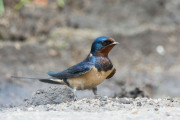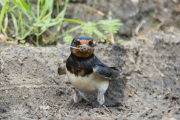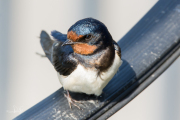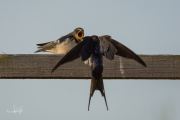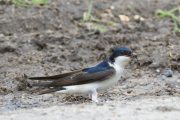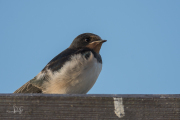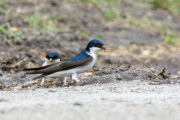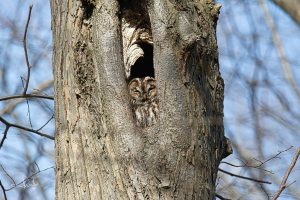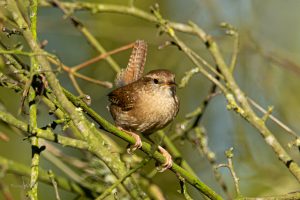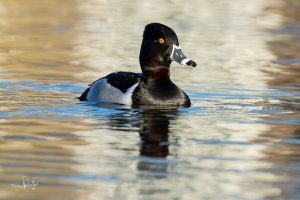On the extraordinary achievements of an ordinary bird
One of these days I hope to find one in my mailbox, a postcard from Ivory Coast. Or Angola, or the Central African Republic, or … It doesn’t matter, at least from Africa where it’s warmer than over here in the Netherlands. A postcard with a photograph of a mixed group of common house martins (Delichon urbicum), barn swallows (Hirundo rustica), sand martins (Riparia riparia) and common swifts (Apus apus).
Bathing in the African sun, feasting on delicious flies that are abundantly present in the air. Because suddenly they are no longer here in the Netherlands. From the beginning of April, I keep a close look at the sky for their arrival. But when the birds are preparing to go south in September and October, you hardly notice that they are no longer here. So at a given moment you suddenly realisethat you are not seeing any house martins or barn swallows anymore. But were they still here yesterday? Or the day before yesterday? When did I see the last one?
Putting their lives at risk
These little birds are real top performers. Just think about it: every year thousands of kilometers they fly both back and forth. Simply on their own steam. Of course, it is not only the swallows, swifts and martins which make this epic journey, just think of birds like chiffchaffs, warblers and redstarts but also for instance godwits and terns. They come and go every year. Driven by food. Thousands of miles over land and sea. Many of them don’t survive this journey as a result of malnutrition and weakening. Or, and unfortunately this still happens in large numbers, they are shot out of the skies in some countries. To eat (though it’s more a snack, because a bird of about 15 to 25 grams doesn’t give much meat) or just for fun because hunters also have the right to pursue their hobbies.
The weather also doesn’t always cooperate and the birds have to face storms and rain along their way. And of course the natural enemies that they have to avoid along the way such as peregrine falcons, sparrow hawks and goshawks, which snatch the birds effortlessly during their flight.
The journey is therefore a perilous one, and it’s very special that so many birds return in spring to our country. As a human being, we are nothing compared to these little ones.Could you imagine traveling 7500 kilometers on foot or by swimming, without using public transport or hitchhiking, all the way to Côte d’Ivoire?Those little birds do it in about 30 days, that’s an average of 250 kilometers per day. But they must also rest and eat, so effectively they’re flying for about 21 days. That is almost 360 km a day. A human simply can’t manage that. By the time you approach the French-Spanish border you have to return, because in spring you have to be back in the Netherlands to build a nest and mate. If you still have the energy for that.
Ten months in the air
Swallows and most martins are not built to sit on the ground and forage extensively. Their short legs are not meant for that either. The only time they will touch the earth’s surface is to collect clay and mud for their nest construction, as you can see in the photos. But that applies to the house martin and barn swallow.
Sand martins and common swifts are very rarely seen on the ground, because they breed in cavities. The sand martin digs its nest out in steep, sandy banks. Many construction project are put on hold for months because a colony of sand martins chose to nest in a mound of sand. As long as these birds are breeding, they are legally protected from disturbance. Why do they do that, why are they breeding there? Simply because there is a lack of naturally occuring steep slopes. And that is why they take every opportunity to colonize.
Common swifts traditionally breed in buildings, also in colonies. By nature these are birds that breed on rock cliffs, but due to the lack of cliffs in our flat country they breed in church towers and under roofs. In recent years they have sometimes also been helped by construction projects utilizingspecial hollow bricks with entrances for the birds. This has already resulted in several successful breeding colonies.
The common swift can be called the record holder for the longest continuous flight. Research has shown that these creatures are in the air for as long as 10 months without even touching the ground. Also in terms of speed there are not many birds that can keep up with them. These birds can reach speeds of up to 200 km/h in a dive. And it keeps flying in search of insects. Very important, because an adult common swift eats about 15 000 insects per day. Martins and swallows have slightly lower requirements, but still account for almost 8000 insects per day. Can you imagine how many insects would fly around when these aerial acrobats are gone forever?
For the time being, we have to do with their photos for a few months. At least until April, because then they will be here again. At least for now, fortunately.
This post was originally published in Dutch on November 14th 2016



